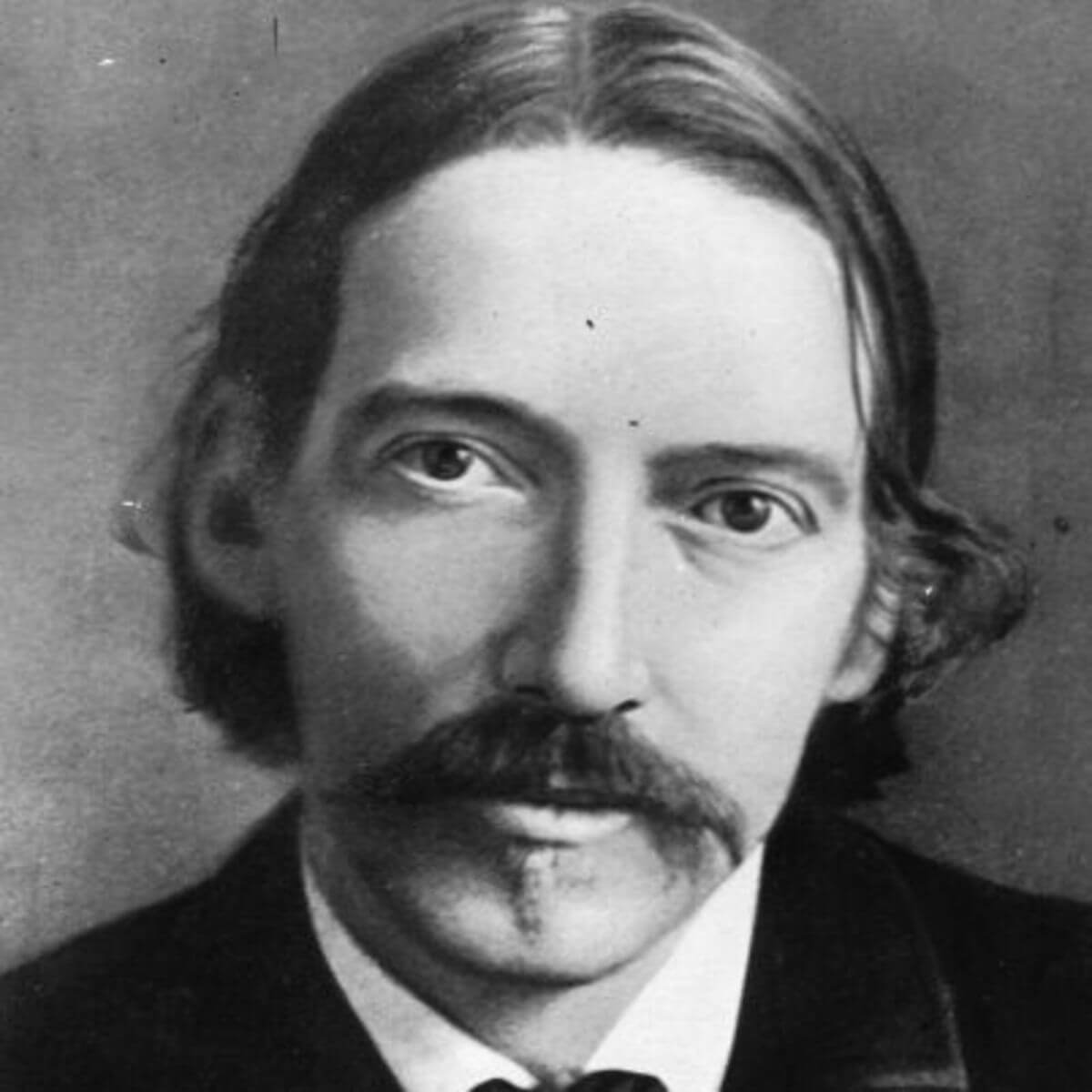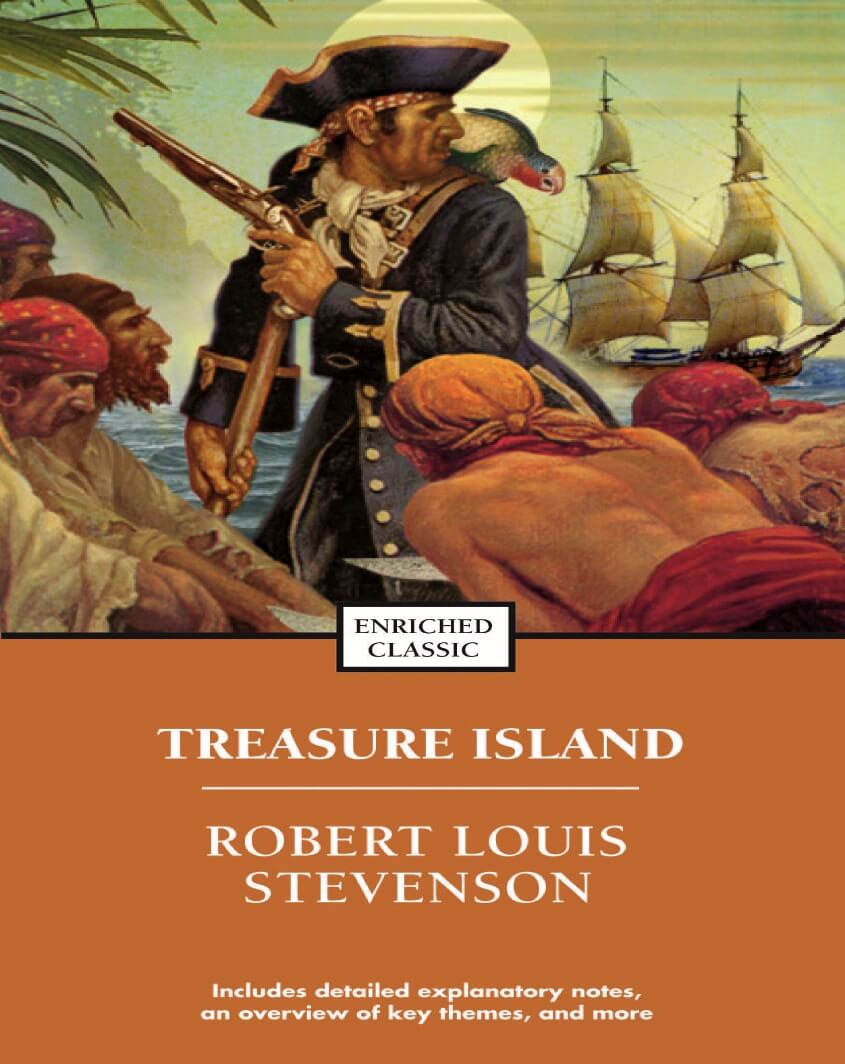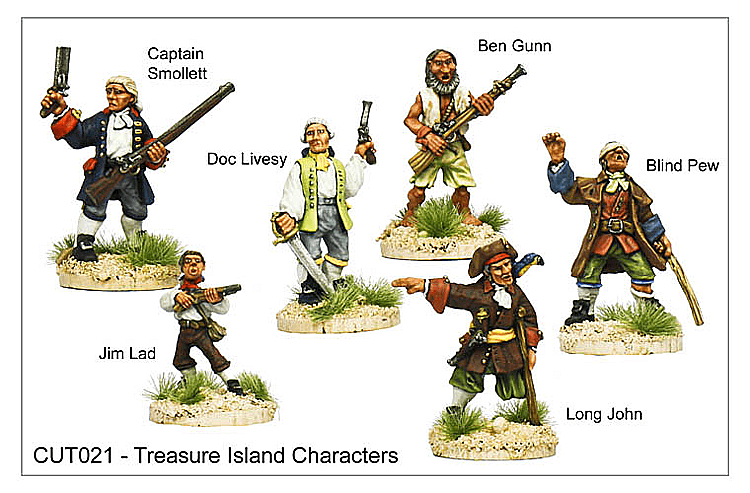Treasure Island SummaryIntroductionRobert Louis Stevenson, a Scottish novelist, wrote the adventure book Treasure Island, which was originally named The Sea Cook: A Tale for Boys and told the tale of "buccaneers and hidden gold." It's known for its location, cast of people, and action and is regarded as a coming-of-age narrative. The book's first publishing ran between 1881 - 1882 within the kid's magazine Young Folks under the heading Treasure Island or the Mutiny of the Hispaniola, using another name, "Captain George North," listed as the author. On November 14th, 1883, Cassell & Co. released the book version for the first time. Since then, it has been considered one of the most commonly portrayed and adapted books across a variety of media. Since the book's release, Treasure Island has greatly impacted how pirates are portrayed in everyday life. This effect can be seen in things like desolate tropical islands, treasure chests with an "X" on them, and one-legged sailors with parrots seated on their shoulders. About the AuthorRobert Louis Stevenson worked as a Scottish author, essayist, poet, and adventure author. His most famous works are Kidnapped, Treasure Island, and Strange Case of Dr. Jekyll and Mr. Hyde, and A Child's Garden of Verses. 
Stevenson was an Edinburgh native who received his education there. While having severe bronchial problems for most of his life, he managed to travel far and write a lot while being in terrible physical condition. He was driven by Andrew Lang, Edmund Gosse, Leslie Stephen, and W. E. Henley as a youngster, the last two of whom might have served as a role models for Long John Silver in Treasure Island. He also received support from Andrew Lang, Edmund Gosse, and Leslie Stephen. He moved to Samoa in 1890 and was disturbed by the growing American and European presence in the South Sea islands. His work began to shift away from romance and adventure literature and towards a grimmer reality. He had a stroke in 1894, when he was 44, and passed away at his island home. Stevenson was well-known during his lifetime, but his reputation among critics has wavered after his passing. Nevertheless, his writings continue to get widespread praise today. He came in at the number 26 spot on the list of most translation authors in the world in 2018, just below Charles Dickens. Summary
In the middle of the eighteenth century, an elderly seafarer who goes by "the captain" but is really Billy Bones stays at the Admiral Benbow Inn on the English coast, paying Jim Hawkins a few pence to keep an eye out for "seafaring men." Billy, who consumes much too much rum, is startled by one of them and has a stroke. Billy then informs Jim that his old shipmates are lusting for the items in his sea chest. Billy has another stroke and passes away after a visit from another guy. Jim and his mother?his father had passed away only a few days earlier?then open the sea box and discover some cash, a notebook, and a map. Dr. Livesey, a local doctor, surmises from the map that it depicts an island where the pirate Flint hid a large amount of loot. Trelawney, the area squire, suggests hiring a ship and sailing in search of wealth while having Jim on board as a cabin boy and Livesey as the ship's doctor. A few weeks later, Trelawney calls for Jim & Livesey and introduces them to Long John Silver, a barman from Bristol who he has recruited to be the ship's chef. They also run across Captain Smollett, who informs them that he dislikes both the crew and the expedition?which appears to be a quest for treasure?of which everyone in Bristol is aware. However, after taking a few safety measures, they set sail toward the far-off island. The first mate, a drunk, jumps overboard during the cruise. Then, shortly before the island is seen, Jim overhears Silver discussing something with two other crew members and realizes that he and the majority of the others are pirates and have prepared a revolt. Jim alerts the captain, Trelawney, and Livesey to the situation, and they determine that they will have a seven to nineteen-to-one advantage over the mutineers and must act as if nothing is amiss until the treasure is discovered, at which point they may surprise the opponents. Silver and a couple of the remaining members of the crew walk onshore after the ship has moored, and two men who don't want to join the rebellion are murdered; one of them gives out quite a loud scream that everyone realizes there is no purpose in pretending anymore. Jim has impulsively accompanied the shore party, and as he escapes from them, he meets Ben Gunn, a half-crazy Englishman, who professes that he has been stuck here and is willing to aid in the fight against the bandits in return for a ride home and a portion of the treasure. Smollett, Trelawney, and Livesey depart the ship in the meanwhile and land to take up home in a stockade with Trelawney's three slaves, one of the other men, Abraham Grey, and a few of the other workers. The remaining crew members hoist up the pirate flag under the leadership of the coxswain, Israel Hands. The battle to reach the stockade brings about the deaths of one of Trelawney's slaves and one of the pirates. The ship's cannon continues an attack on them until the end of the day when Jim discovers the stockade and joins them. The next morning Silver reappears under a peace flag, giving Captain Smollett necessitate that he rejects and declaring that another pirate had been murdered the night prior (by Ben Gunn, Jim realizes, but Silver does not). When Silver warns to come after because Smollett won't give over the map, the attack on the stockade takes place shortly after. After a fight, the still-alive rebels flee after losing six of their number, but the captain's squad has lost two more members, and Smollett has suffered serious injuries. Jim escapes without permission and discovers Ben Gunn's makeshift boat as Livesey departs in pursuit of him. He leaves the ship cut loose after the sun goes down. The ship sails towards the sea on the ebb tide with Jim's boat in her wake. The two pirates on the surface, Hands and O'Brien, break off their boozy argument and race on decks. Jim, who is exhausted, falls asleep in the boat and wakes up the next morning while being pushed by a northerly current down the island's west shore. When he eventually discovers the ship, it seems to be empty; however, when he gets aboard, he discovers O'Brien dead and Hands seriously injured. They decide to anchor the ship in a port on the island's northern shore. He and Hands come to this decision together. However, when the ship is eventually stuck, Jim kills and shoots Hands when he tries to murder Jim. He returns to land and makes his way to the stockade after doing his best to secure the ship. He arrives at the location in total darkness, enters the blockhouse, and is met by Silver and the five mutineers who are still inside, who had somehow managed to seize control of the stockade while he was away. Silver convinces the other guys out of killing Jim during their argument. When everyone realized the ship had vanished, he referred to Jim; the captain's group signed a pact in which they promised to give up the stockade and the chart. In the morning, Dr. Livesey comes there to heal the ill and injured pirates, and he warns Silver to be on the lookout for disaster when they arrive at the location of the loot. Silver and the others go after him, bringing Jim with them with the chart. They finally find the treasure stash, but it is empty. Two of the pirates emerge, Silver and Jim, but Livesey, Grey, and Ben Gunn trap them and shoot them down. The other three flee, and Livesey states that Gunn had already found the wealth and brought it to his cave long ago. The three surviving rebellions, along with their food and ammo, are left behind throughout the next several days while they load the riches aboard the ship. Silver grabs a sack of cash and flees from their first port, where they would sign up additional personnel. The remaining crew members return to Bristol and share the loot. Jim claims that there is still more on the island, yet he, for one, refuses to undertake another journey to get it. Treasure Island Theme
Book's Characters
1. Jim HawkinsThe young (presumably between 13 and 14) The experience of Treasure Island is described from Jim Hawkins' point of view. The reader connects to and interprets the tale via his emotions, perceptions, and sentiments. Jim Hawkins is a regular little kid who, by no fault of his own, finds himself in the greatest adventure imaginable for a youngster his age. By making bold and often extremely dangerous decisions, Jim evolves from an observer who watches to a proactive actor who controls his own destiny. Although it isn't because of his courage or any unique abilities, it is he, rather than the older, more experienced men on the voyage, who discover the pirates' plans for a mutiny, identify Ben Gunn, and urge him to support them, and seize the Hispaniola before giving it back to the captain. Jim is an intelligent individual who has developed into a youngster who is able to succeed at the conclusion of the novel. His development as a person is complete in his victory against Israel Hands on the Hispaniola, and his ethical maturation is full in his choice not to flee from Long John Silver despite Dr. Livesey's advice. Long after he returns from Treasure Island, Jim suffers from torture by Long John Silver and his parrot in his nightmares as he heads back home to write the narrative. 2. Mrs. Hawkins (Jim's mother)The lone female character in the novel makes a momentary cameo at the opening of Treasure Island.Her behavior in ensuring that she receives what is rightfully hers from Billy Bone's treasure best reveals her character. She presents a good example for Jim to observe later in the novel by having the courage to turn around and walk back to the inn despite being in serious danger. 3. Billy BonesThe very first pirate Jim discovers in the novel is Billy Bones, whose appearance?ragged, damaged, with a ponytail and a wound on his cheek?marks the end of peace at the inn. The fact that he seeks out the Admiral Benbow inn shows that he is unwilling to be abducted despite his drinking (particularly rum) and singing of a song with a blatantly pirate melody. Jim is not terrified of Billy Bones despite the fact that he exhibits this questionable behavior; in fact, he even finds the excitement the sailor provides to the usually deserted island to be enjoyable. Billy Bones treats the little lad well in return. Billy Bones is a precursor of the compassionate, maternal, and gentle part of Long John Silver's persona that emerges when he teams up with the "good" soldiers. He may be arrogant, but behind it all, he has a wonderful heart. At the end of the first section of the novel, Jim is sincerely saddened by his stroke-related death. 4. Doctor LiveseyDr. Livesey is portrayed as an impartial arbiter who is smart, brave, and well-organized from the very first page of Treasure Island. Throughout the course of the story, he becomes one of many different kinds of substitute parents for Jim as he gets engaged in the treasure quest and also exhibits concern and compassion for Jim. The book also includes Dr. Livesey is a narrator, although for a brief period of time. Contrary to the chapters that are told by the younger Jim, these chapters are not quite as vibrant or as dramatic. By continually mentioning malaria found in the wetlands, he furthers his portrayal as a scientist who is primarily interested in healing the ill. The fact that Dr. Livesy was worried about the pirates they had to leave behind shows how seriously he takes the idea of justice for everyone. 5. Black DogHe was Billy Bones' companion, and his appearance at the Admiral Benbow Inn signalled the outbreak of hostility there, as well as the knowledge that other pirates were aware of Bones' existence. Despite the fact that they are amicable, he and Billy Bones end up fighting, and Billy Bones suffers damage. 6. PewPew is another individual who comes out to Admiral Benbow in an attempt to sneak up on Billy Bones and steal the treasure map. Pew is beautifully characterized initially as a blind old guy who "rat-tap-taps" with his stick, but cleverly also as a terrible, malicious foe who is eager to utilize physical strength to intimidate people around him. Pew anticipates Long John Silver's more violent side, which is capable of great brutality despite his physical limitations. Pew is left alone at the conclusion of part I and is eventually crushed by a horse. 7. Squire TrelawneyThe character that describes and starts the treasure search in the novel is Squire Trealwney. Even though he seems to have everything under control, he often makes errors. The job of Long John Silver and the mutineers put him at the helm of the litany of errors and mistakes that cause the voyage to fail. He is often taken advantage of because of his extreme trustworthiness and naivete. His most powerful talent is his accuracy; because of this, he always gets the assignments that call for the best shot. 8. Captain SmollettThe Hispanolia's captain is the opposite of the Squire; he is astute, intelligent, and terrified of the perils that await the voyage?an attitude that turns out to be accurate. He is at clashes with the Squire, whose position of power he fails to respect, as well as Jim, who displays a rebellious desire against an authoritative figure, and he wants loyalty from those who work beneath him. 9. RedruthHe becomes one of the very first "good" men who dies when the team tries to capture the stockade; he is the Squire's servant and travels with the crew to the island. 10. Long John SilverJim's companion and the pirates' captain, Long John Silver, is an elderly naval chef. With just one leg, this lively guy is often joined by Captain Flint, his parrot, who cries out, "Pieces of Eight, Pieces of Eight." According to many reviewers, the book's actual hero is Long John Silver, not Hawkins's character or Flint's treasure. This conclusion was apparently shared by Robert Louis Stevenson since his original title for this book was "The Sea Cook." For this reason, many reviewers also see Long John Silver as a predecessor to Dr. Jekyll and Mr. Hyde. Long John Silver is a character who obviously has multiple personalities throughout the whole book. According to some theories, Silver is a combination of two pirates who first appear in the story before Silver does. The two main characters are the blind beggar Pew and Billy Bones, a screaming buccaneer who is primarily helpful and compassionate to Jim despite his physical impairment. There are moments when Silver treats the young narrator with extraordinary tenderness and paternal affection. . However, Silver displays immense violence and cruelty at other moments by murdering other sailors despite not being human like Pew. 11. Israel HandsIsrael Hands, a "bad" pirate who displays an undoubtedly "evil" side by being fraudulent and cunning in whatever he does, is an integral part of the band of pirates. He lives by the motto "live or dies," killing only if it prevents him from dying. Jim nearly forgets to be suspicious of the character as he enjoys beaching aboard the vessel too much when he sees him on the Hisapnolia, where he also exhibits a side that is vivacious and paternal. Jim murders Israel Hands for the first time, and he has no regrets about doing it. 12. Ben GunnAt the island, Ben Gunn brings humorous relief, which is an inhalation of fresh air in a very stressful section of the novel. Ben Gunn, who was a part of Flint's initial crew, ended up stuck on the island for three years and was forced to care for himself. He discovered Flint's riches by accident and hid them, protecting them from the pirates who attempt to assassinate Silver and Jim. He offers the opportunity for escape and is friendly with Jim and the remaining members of Jim's crew. Despite the pirates' claims to the contrary, he demonstrates his intelligence and agility by making it off the island alive. Even though he used up his share of the wealth in only three weeks, he returned with every one of them.
Next TopicTughlaq Summary By Girish Karnad
|
 For Videos Join Our Youtube Channel: Join Now
For Videos Join Our Youtube Channel: Join Now
Feedback
- Send your Feedback to [email protected]
Help Others, Please Share









